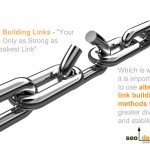While providing an SEO consultation a few days ago, the client had a severe problem with bleeding ranking factor from using recurring elements of navigation on the sidebar of their website.

SEO Navigation Tip: Minimize Internal Sidebar Links
In layman’s terms, there were too many links in the sidebar. While it may seem like “the logical thing to do” to put all your products or services on the sidebar in your template globally, for optimal results one should use secondary navigation sparingly for two distinct reasons.
Aside from SEO, the first reason is (1) relevance the second reason is (2) to avoid information overload for users attempting to navigate your website. While these two points are related, at the end of this post, I’ll provide a feasible alternative to minimize excessive navigation and excessive internal links to create an optimal navigation structure to complement SEO results.
Why Excessive Links Cripple SEO
The more links you have on a page, the more link loss you can experience. If you have over 100 links on a page, the fraction of link-flow moving through those links is minimized considerably every time you add another. In other words, the link equity is divided by the volume of outbound or internal links.
This means that instead of 10, 20 or 30 strong links from a page (that could rank another page, which could rank another page and so on) you end up with 100 weak pages including the one with the links hemorrhaging the links in the first place.
This also applies to internal links on a page, if there are excessive internal links, then the SEO value is undermined and you should consider 1 link for every 100 words minimum for internal links (10 internal links for a 1000 word page) or 1 internal link for every 200 words (5 internal links for a 1000 word page) to really augment the links and increase link flow through contextual relevance.
Search engines rank pages, not websites, so if your website is a collection of weak pages, then you’ve just removed your website from the ranking and profit equation.
Another “Non SEO” Reason to Minimize Links
Consider that there are many ways to reach a webpage (a search engine, from within the website, from a banner or ad on another website, etc.), but once they are on your website, they should only be presented with relevant options to navigate (and this was the problem).
Factoring usability as a viable metric is often overlooked for webmasters seeking to funnel visitors without first deciding on conversion paths.
However, you have to consider what you reveal to which visitors and whether or not the information is relevant at the time for that user.
If you have irrelevant information presented globally on your website, you are bound to antagonize users or frustrate them from having to wade through links to find what they need.
This “presentation of excessive information” only encourages a user to bounce from your website as quickly as they appeared and find a less self-aggrandizing / cluttered website which possesses a clear product, service, conversion path or solution.
In either scenario (information overload or SEO), it’s about sculpting (a) the more optimal user experience which allows them to find what they want, when they want and easily facilitate a purchase and (b) making sure that the link equity of each page is preserved so it can rank and pass along ranking factor to other websites.
Now, The Solution!
For this navigation alternative, break your navigation into bite size chunks and consider, is this path relevant to my user? Can I use internal links to augment a user path or perhaps add footer links or refer them back to the parent category with breadcrumbs or opt for using the primary navigation instead?
Why have a page with 100 links, when you could have 10 pages with 10 links, 5 pages with 20 links, 3 pages with 33 links, etc. to minimize the number of links from the initial page to 3, 5 or 10 outbound/internal links. Consolidation unifies PageRank and creates buoyancy through ring-fencing the flow of link juice (capping and corralling it to flow into pages that need more ranking factor).
While the scale of a website determines what should appear (other related categories or nested products perhaps) you still have to consider information and site architecture from the top down before building out your website.
One SEO Navigation Tip Is:
- Create a new landing page (to function as a hub page) now instead of having 30 links on a sidebar, have one link to that new landing / hub page.
- Now place those 30 links on that hub page instead of the sidebar.
- The hub page allows you to (a) present relevant information which allows a user to navigate and (b) limits the link loss on the global sidebar region of your website.
You can rinse and repeat as needed and try to scale all outbound or internal links on each page through this type of consolidation to minimize noise and provide an optimal user experience. Then, you can even rename the link to the hub page something SEO or user friendly.
If you do not want that page to interfere with SEO, you can also use it with a noindex, follow command in the meta data to pass the link equity through the page, without having it incur a duplicate content penalty if you have other incidents of pages with a high frequency of links and minimal content.








Thanks for the advice I think I will remove some of my links as I have a 2 nav menus one at the top and one in the side bar
Don’t force all navigation downwards through drop down menus. It is frustrating for a user who just wants to browse a subject area to have to click on a drop down box every time they want to move to another item..
Agreed, just use bullets or secondary navigation above the fold on the sidebar preferably on the left (which is the most clicked / viewed heatmap region on a page anyway for navigation)…
This is such a confusing area. If internal links dilute SEO, it’s hard to explain the success of Wikipedia which has a gazillion links on every page. Often the same link is repeated throughout an article. Yet Wikipedia is right up there when you google just about anything! Do these principles apply only to navigation (whether drop down or sidebar) or do they apply to links in the page content too? If they do, nobody seems to have told Wikipedia. Or Google, for that matter, since they consistently put Wikipedia high up the lists in searches.
Wikipedia has enough link flow from inbound links to offset link attrition. It also represents the ideal semantic model and they silo each page to rank for a very specific keyword, then contextually link to other related topics/keywords (which in turn link back to that page).
Wikipedia is Google proof (as an authority site), so, the ratios which would kill a normal site do not apply. It also recives lin flow from other pages that have been linked to. So, if Page A has 1000 inbound links to it and it links to 10 pages, those 10 pages also get link from from it. They have taken this principle and pushed it to immense proportions, so, search engines find this content fresh, relevant and with heavy citation / links from others it represents “the perfect answer” algorithmically for millions of keywords.